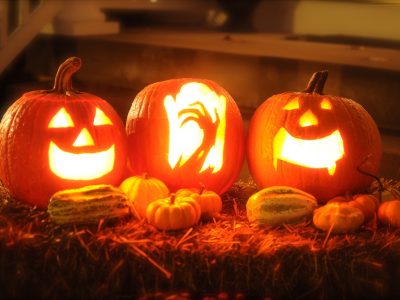Halloween is a beloved holiday celebrated around the world on 31 October. It is a time filled with spooky costumes, jack-o’-lanterns, and trick-or-treating. But have you ever wondered how these traditions came to be? The history of Halloween is rich and fascinating, with roots that trace back thousands of years.
Ancient origins of Halloween
The origins of Halloween can be traced back to the ancient Celtic festival of Samhain. The Celts, who lived in what is now Ireland, the United Kingdom, and northern France, celebrated Samhain as the end of summer and the beginning of the dark, cold winter. They believed that on the night of 31 October, the boundary between the world of the living and the world of the dead became blurred, allowing spirits to roam the earth.
To ward off these spirits, the Celts would light bonfires and wear costumes made of animal heads and skins. They also believed that the presence of these spirits made it easier for Druids, Celtic priests, to make predictions about the future. The Celts would gather around the bonfires, where sacrifices of crops and animals were made, and listen to the Druids’ prophecies.
As the influence of the Roman Empire spread, two Roman festivals, Feralia and a day to honour Pomona, were incorporated into Samhain. Feralia was a day to commemorate the passing of the dead, while Pomona was the Roman goddess of fruit and trees. The tradition of bobbing for apples, which is still practised today, likely originated from the association of apples with Pomona.
The influence of Christianity
In the 8th century, Pope Gregory III designated 1 November as All Saints’ Day, a time to honour all saints. The evening before All Saints’ Day, known as All Hallows Eve, eventually became Halloween. The Catholic Church aimed to replace the pagan festival of Samhain with a Christian holiday.
Over time, the traditions of Samhain blended with those of All Saints’ Day. All Souls’ Day, established in the 9th century, was a day to honour the dead. The church believed that by celebrating these holidays, they could comfort people during the long, dark winter and replace the Celtic festival of the dead with a church-sanctioned celebration.
Halloween in America
The celebration of Halloween was brought to America by Irish and Scottish immigrants in the 19th century. They introduced the tradition of dressing up in costumes and going door-to-door for food or money, which eventually became known as trick-or-treating.
In the early days of Halloween in America, the holiday was primarily celebrated in Maryland and the southern colonies. However, as more immigrants arrived and the tradition spread, Halloween parties and festivities became more common throughout the country. By the mid-20th century, Halloween had become a widely celebrated holiday in America.
Classic Halloween traditions
Carving jack-o’-Llanterns
One of the most iconic Halloween traditions is carving jack-o’-lanterns. This tradition originated in Ireland, where turnips were carved with scary faces to ward off evil spirits. When Irish immigrants came to America, they discovered that pumpkins, which were more readily available, were the perfect substitute for turnips. Today, carving pumpkins has become a beloved Halloween activity for people of all ages.
Seeing ghosts
The belief in ghosts and spirits has long been associated with Halloween. The ancient Celts believed that on the night of Samhain, the spirits of the dead would return to Earth. This belief has carried over into modern Halloween celebrations, with ghosts and haunted houses being popular motifs.
Wearing scary costumes
Dressing up in costumes is a central part of Halloween. The tradition of wearing scary costumes can be traced back to the ancient Celts, who believed that disguising themselves would protect them from the spirits that roamed the Earth on Samhain. Today, Halloween costumes range from spooky to cute, with people of all ages enjoying the fun.
Trick-or-treating
Trick-or-treating has become synonymous with Halloween. The tradition of going door-to-door and collecting treats can be traced back to several different customs. Some believe that it originated from the Celtic practice of leaving food out for spirits in exchange for protection. Others think it evolved from the Scottish tradition of guising, where children would perform a trick, such as singing a song or telling a joke, in exchange for treats.
Black cats
Black cats have long been associated with Halloween and superstitions. In ancient times, they were believed to be the companions of witches and were considered a symbol of bad luck. Today, black cats are often seen as Halloween icons and featured in decorations and costumes.
Black and orange
The colours black and orange have become synonymous with Halloween. Black represents the darkness of the season and the presence of spirits, while orange symbolises the autumn harvest. These colours can be seen in Halloween decorations, costumes, and candy.
Bobbing for apples
Bobbing for apples is a classic Halloween game that has its roots in Roman and Celtic traditions. In Roman times, apples were associated with Pomona, the goddess of fruit and trees. The game of bobbing for apples became popular as a way to predict future romances. Participants would try to bite into an apple floating in water using only their mouths, and the first person to succeed would be the next to marry.
Pranking
Playing pranks on Halloween, also known as Mischief Night, has a long history. The tradition of pranking can be traced back to Samhain, where mischievous activities were believed to bring good luck. While pranking is less common today, it still remains a part of Halloween folklore.
Lighting candles and bonfires
The lighting of candles and bonfires has been a part of Halloween celebrations since ancient times. In the past, bonfires were used to ward off evil spirits and provide light during the dark winter nights. Today, candles are often used to create a spooky atmosphere and are a common decoration during Halloween.
Devouring candy
Candy has become synonymous with Halloween, with children and adults indulging in sweet treats. The tradition of giving out candy on Halloween can be traced back to the early 20th century when candy companies began marketing individually wrapped candies specifically for trick-or-treating. Today, candy corn, chocolate bars, and other sugary delights are enjoyed by many on Halloween night.
From its ancient origins as the Celtic festival of Samhain to the modern-day traditions of trick-or-treating and costume parties, Halloween continues to captivate people of all ages.





